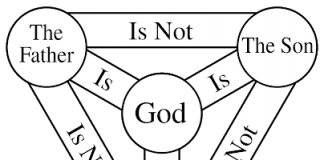
| Date | Event | ||
| AD 51-125 |
The New Testament books are written. | ||
| 140 | Marcion, a businessman in Rome, taught that there were two Gods: Yahweh, the cruel God of the Old Testament, and Abba, the kind father of the New Testament. Marcion eliminated the Old Testament as scriptures and, since he was anti-Semitic, kept from the New Testament only 10 letters of Paul and 2/3 of Luke’s gospel (he deleted references to Jesus’ Jewishness). Marcion’s “New Testament”, the first to be compiled, forced the mainstream Church to decide on a core canon: the four Gospels and Letters of Paul. | ||
| 200 | The periphery of the canon is not yet determined. According to one list, compiled at Rome c. AD 200 (the Muratorian Canon), the NT consists of the 4 gospels; Acts; 13 letters of Paul (Hebrews is not included); 3 of the 7 General Epistles (1-2 John and Jude); and also the Apocalypse of Peter. Each “city-church” (region) has its own Canon, which is a list of books approved for reading at Mass (Liturgy) | ||
| 367 | The earliest extant list of the books of the NT, in exactly the number and order in which we presently have them, is written by Athanasius, Bishop of Alexandria, in his Festal letter # 39 of 367 A.D. (Arianism starts introducing spurious books) | ||
| 382 | Council of Rome (whereby Pope Damasus started the ball rolling for the defining of a universal canon for all city-churches). Listed the New Testament books in their present number and order. | ||
| 393 | The Council of Hippo, which began “arguing it out.” Canon proposed by Bishop Athanasius. | ||
| 397 | The Council of Carthage, which refined the canon for the Western Church, sending it back to Pope Innocent for ratification. In the East, the canonical process was hampered by a number of schisms (esp. within the Church of Antioch). However, this changed by … | ||
| AD 405 | Innocent sends a response to Exsuperius, bishop of Toulouse
1. The Latin text here conforms to the one printed in B.F. Westcott, A General Survey of the History of the Canon of the New Testament (5th ed. Edinburgh, 1881), pp. 570f. 2. That is, First and Second Samuel and First and Second Kings. 3. According to Augustine, five books were sometimes ascribed to Solomon: Proverbs, Ecclesiastes, Song of Songs, Wisdom of Solomon, and Ecclesiasticus. 4. That is, Ezra and Nehemiah. 5. F.F. Bruce prefers “thirteen” here, which implies the omission of Hebrews. He states that “the three best” copies of the letter “reckon Paul’s epistles as thirteen (written xiii), but the rest reckon them as fourteen (written xiiii).” (Canon of Scripture, p. 234.) But it is not at all probable that Hebrews would have been deliberately omitted from the list by a Roman bishop in the year 405, and the variation between xiiii and xiii is easily explained by scribal error. http://www.bible-researcher.com/innocent.html |
||
| AD787 | The Ecumenical Council of Nicaea II, which adopted the canon of Carthage. At this point, both the Latin West and the Greek / Byzantine East had the same canon. However, … The non-Greek, Monophysite and Nestorian Churches of the East (the Copts, the Ethiopians, the Syrians, the Armenians, the Syro-Malankars, the Chaldeans, and the Malabars) were still left out. But these Churches came together in agreement, in 1442A.D., in Florence. | ||
| 1442 | AD : At the Council of Florence, the entire Church recognized the 27 books. This council confirmed the Roman Catholic Canon of the Bible which Pope Damasus I had published a thousand years earlier. So, by 1439, all orthodox branches of the Church were legally bound to the same canon. This is 100 years before the Reformation. | ||
| 1536 | In his translation of the Bible from Greek into German, Luther removed 4 N.T. books (Hebrews, James, Jude, and Revelation) and placed them in an appendix saying they were less than canonical. | ||
| 1546 | At the Council of Trent, the Catholic Church reaffirmed once and for all the full list of 27 books. The council also confirmed the inclusion of the Deuterocanonical books which had been a part of the Bible canon since the early Church and was confirmed at the councils of 393 AD, 373, 787 and 1442 AD. At Trent Rome actually dogmatized the canon, making it more than a matter of canon law, which had been the case up to that point, closing it for good. |
The term “canon” means is that a book is approved for reading at the Divine Liturgy –that is, the Mass. This is what “canon” (a Greek word meaning “rule”) originally referred to. The “canonical” books were those books which were approved for reading at the Liturgy.
Books which were not approved for reading at the Liturgy were called “apocryphal” (or “hidden”), and so excluded from the Liturgy. Among the “apocryphal” books, some were considered to be very orthodox and even inspired (but still not approved for public reading at the Liturgy), and others were considered to be uninspired or to contain errors (or even to be outright heretical). Only the “canonical” books were approved for reading at the Liturgy (the Mass).
Before the late 4th Century, each city-church had its own, local “canon” of the Bible, and these local canons differed from city-church to city-church —some local canons including books which are currently excluded from our present Bible (such as 1 Clement to the Corinthians, or the Epistle of Barnabas, or the Book of Enoch, etc.), and some local canons excluding books which are currently included in our present Bible (such as the Epistle of James, and Hebrews, and 2 Peter, and 2 & 3 John, Jude, and Revelation). The reason that city-churches had different local canons is because city-churches had different local Liturgies –that is, the Liturgy (form of worship) in the city-church of Rome was different from the Liturgy (form of worship) in the city-Church of Corinth, or the city-church of Ephesus, or Antioch, or Jerusalem, etc. This included the yearly Liturgical calendar, with different city-churches celebrating different local feast days on any given date.
Since the feast days differed, so did the corresponding readings for those feast days; and since there were only so many Liturgical readings (from so many canonical books) that a city-church could have in a given year, this limited the number of books in the local canon of that city-church.
As the Church entered the 4th Century, there was no such thing as one, universal “Bible”
(one universal Scriptural canon, which the entire, universal Church shared in common).
When the Arian heresy ripped the Church apart (pitting bishop against bishop, and city-church against city-church), this created an enormous problem, since you had different bishops (Arian vs. Catholic) quoting from different books (or sets of books) in defense of either Arianism or Catholic Trinitarianism. Needless to say, this complicated and prolonged the controversy, and made Arianism much harder to defeat. Well, by the year 382, when the Arian heresy was finally defeated, Pope St. Damasus of Rome (who had been the librarian for the church of Rome prior to becoming Pope) took it upon himself to correct this problem, and to guarantee that it would not happen again, by initiating steps for the formation of a universal canon of Scripture which all city-churches would hold in common, which would eliminate any book which even impliedArianism (or other condemned heresies).
To “start the ball rolling” on this, Pope Damasus promoted a Biblical canon which was a synthesis of the canon of the city-church of Rome and that of the city-church of Alexandria –the two leading city-churches of the universal Church. Damasus then turned this proposed canon over to the bishops of North Africa for analysis and debate. And he did this for four reasons:
- North Africa was not part of the theology schools of either Alexandria or Antioch, which were the two intellectual factions that had caused the Arian controversy.
- North Africa had the most bishops per capita of anywhere in the universal Church at the time, so they would reflect a good sample of universal opinion among the bishops.
- The North African Church had a traditional custom of meeting in council (either at Carthage or at Hippo) every two years, which would give them the ability to hash things out effectively; and
- Many of the North African bishops were renowned scholars, such as St. Augustine of Hippo, who participated in the debate and helped to formulate the canon.
So, at both the councils of Hippo (393) and at Carthage (397), the North African bishops worked out the final canon of the both the Old and New Testaments for the universal Church. This is the present canon of the Catholic Church, which the North Africans then submitted to Rome for final ratification. Now, we’re not sure when this final ratification was given, but we do know that, by A.D. 405, Pope St. Innocent I was promoting the so-called “canon of Carthage” (397) throughout the Western Church. Rome would also have sent rescripts of its decision (final ratification of the Carthaginian canon) to Alexandria, the 2nd See of the universal Church and the primate in the East, with the expectation that Alexandria (as Eastern primate) would disseminate it throughout the East.
Source:http://catholicbridge.com/catholic/timeline_of_how_the_bible_came.php
Funsho Abdulafeez Animashaun




